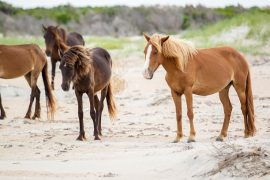Corolla Wild Horses – Managing the Herd (Part 2)
 For almost 500 years, the Spanish mustangs of Corolla have moved freely along the northern Outer Banks. A direct genetic link to the history of our nation, they are absolute proof that the Spanish were exploring the coast of North America far to the north of their settlements in Florida.
For almost 500 years, the Spanish mustangs of Corolla have moved freely along the northern Outer Banks. A direct genetic link to the history of our nation, they are absolute proof that the Spanish were exploring the coast of North America far to the north of their settlements in Florida.
No one is quite sure how the horses came ashore. The most likely scenario would be from a shipwreck off the Currituck Banks, although it is also possible the Spaniards left the horses when they re-embarked on their galleons.
These horses are a unique breed, and genetic testing has shown they are the last remnants of the original Spanish mustangs-horses that were bred to forage in almost any environment, intelligent with an indomitable will.
There are only 101 of these magnificent horses still roaming free at the northern end of the Currituck Banks. The Corolla Wild Horse Fund manages the herd, and there is growing concern that the herd lacks the genetic diversity to survive. According to CWHF Executive Director Karen McCalpin, the entire herd is now descended from one mare. Consistent with genetic inbreeding, birth defects have become common.
Federal legislation introduced by North Carolina Congressman Walter Jones would mandate that three mares from the Shackleford Banks would be introduced into the Corolla herd. The mustangs of the Shackleford Banks are the closest genetic link to the Corolla mustangs. The bill, titled the “Corolla Wild Horses Protection Act,” passed the House unanimously, but has languished in the Senate and has not come to the floor for a vote.
There has been opposition to the bill from US Fish and Wildlife, who manage 2,495 acres of the more than 7,500 acres between the Virginia state line and the end of the paved road in Corolla. To USFW, the horses are an invasive species and endanger the natural habitat by overgrazing.
The House committee reporting on the bill disputed that claim. “While FWS has been unable to quantify any negative impacts on the eight Corolla horses that utilize refuge land, FWS views the Corolla wild horses as an introduced feral animal.”
There are other herds of Spanish mustangs dotting the Outer Banks. The herd on Ocracoke once numbered more than 300 but is now managed at 20 horses in a penned area of 160 acres.
The Shackleford herd lives on Shackleford Island and is managed by the National Park Service. The herd is maintained between 110 and 130 horses on a barrier island that is about one third the size of the land the Corolla herd occupies. The management plan contained in the “Corolla Wild Horses Protection Act” calls for the same herd size.
Although there are concerns about the future of the Corolla herd, the mustangs are still very much a part of the Carova landscape, and there are a number of outfitters in the Corolla area who specialize in safari trips to view the horses.
For anyone seeing the horses, here is a little cautionary advice. It is illegal to approach within 50 feet of the horses, both for the protection of the humans and the mustangs. Peaceful in appearance, beautiful to look upon, they are nonetheless wild animals and can be unpredictable.
Also-do not feed them! There has been one death and several very sick horses over the past three years because people do not realize that human food could be deadly for the horses. As long as you are conscious of these rules, feel free to enjoy the truly majestic Spanish mustangs of the Outer Banks.
